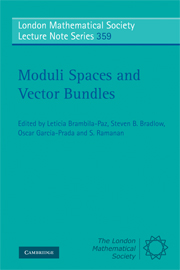Book contents
- Frontmatter
- Contents
- Preface
- Acknowledgments
- Part I Lecture Notes
- Part II Survey Articles
- 7 Moduli of Sheaves from Moduli of Kronecker Modules
- 8 Coherent Systems: a Brief Survey
- 9 Higgs Bundles Surface and Group Representations
- 10 Quotients by Non-Reductive Algebraic Group Actions
- 11 Dualities on T*SUX (2, OX)
- 12 Moduli Spaces for Principal Bundles
- Part III Research Articles
7 - Moduli of Sheaves from Moduli of Kronecker Modules
Published online by Cambridge University Press: 07 September 2011
- Frontmatter
- Contents
- Preface
- Acknowledgments
- Part I Lecture Notes
- Part II Survey Articles
- 7 Moduli of Sheaves from Moduli of Kronecker Modules
- 8 Coherent Systems: a Brief Survey
- 9 Higgs Bundles Surface and Group Representations
- 10 Quotients by Non-Reductive Algebraic Group Actions
- 11 Dualities on T*SUX (2, OX)
- 12 Moduli Spaces for Principal Bundles
- Part III Research Articles
Summary
To Peter Newstead on his 65th birthday
This article is an expository survey of our paper [AK], which provides a new way to think about the construction of moduli spaces of coherent sheaves on projective schemes and the closely related construction of theta functions on such moduli spaces.
More precisely, for any projective scheme X, over an algebraically closed field of arbitrary characteristic, we are interested in the moduli spaces (schemes) of semistable coherent sheaves of OX-modules, with a fixed Hilbert polynomial P with respect to a very ample invertible sheaf O(1).
Such moduli spaces were first constructed for vector bundles on smooth projective curves by Mumford [Mu] and Seshadri [S1], and this was the context where the key ideas were first developed, namely the notions of stability, semistability and S-equivalence. Thus Mumford showed that there was a quasi-projective variety parametrising isomorphism classes of stable bundles, while Seshadri showed that this is a dense open set in a projective variety parametrising S-equivalence classes of semistable bundles.
For modern account of moduli spaces of sheaves and their construction in higher dimensions, see [HL]. Recall that every semistable sheaf has a Jordan-Hölder filtration, or S-filtration, with stable factors and two semistable sheaves are S-equivalent if their associated graded sheaves are isomorphic, i.e. their S-filtrations have isomorphic stable factors (counted with multiplicity).
- Type
- Chapter
- Information
- Moduli Spaces and Vector Bundles , pp. 212 - 228Publisher: Cambridge University PressPrint publication year: 2009
- 4
- Cited by

